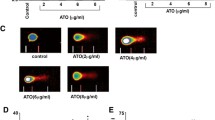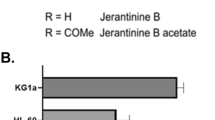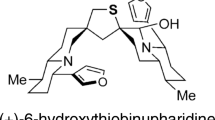Abstract
The primary objective of this study was to determine whether caspases are involved in arsenic trioxide(ATO)-induced apoptosis of human myeloid leukemia cells. A secondary objective was to determine whether apoptosis induced by ATO compared with VP-16 is differentially affected by an activator of protein kinase C (PKC), phorbol 12-myristate 13-acetate (PMA), which has been reported to inhibit apoptosis induced by some chemotherapeutic agents. NB4 and HL60 cells were incubated with ATO in the presence and absence of the caspase protease inhibitors Z-VAD.fmk or Y-VAD. cho. Apoptosis was assessed by morphology, DNA laddering and flow cytometry. Poly (ADP-ribose) polymerase (PARP) cleavage was used as a marker for the activation of caspases. PARP cleavage occurred during ATO-induced apoptosis in both NB4 and HL60 cells. Z-VAD.fmk, a broad-spectrum inhibtor, could block ATO-induced apoptosis and PARP cleavage, whilst Y-VAD. cho, a selective inhibitor of caspase 1, had no such effect. PMA pre-incubation for up to 8 hours under conditions known to activate PKC had no effect on either ATO- or VP-16-induced apoptosis. We conclude that in cultured myeloid leukemia cells ATO-induced apoptosis is executed by caspases from the distal, PARP-cleaving part of the activation cascade and that PKC activation has no effect on apoptosis induced by either ATO or VP-16 in these cells.
Similar content being viewed by others
References
Chen GQet al. In vitro studies on cellular and molecular mechanisms of arsenic trioxide (As2O3) in the treatment of acute promyelocytic leukemia: As2O3 induces NB4 cell apoptosis with downregulation of bcl-2 expression and alteration of PML-RARα/PML protein localization.Blood 1996;88: 1052–1061.
Chen GQet al. Use of arsenic trioxide (As2O3) in the treatment of acute promyelocytic leukemia (APL): I. As2O3 exerts dose-dependent dual effects on APL cells.Blood 1998;89: 3345–3353.
Shen ZXet al. Use of arsenic trioxide (As2O3) in the treatment of acute promyelocytic leukemia (APL): II. Clinical efficacy and pharmacokinetics in relapsed patients.Blood 1997;89: 3354–3360.
Warrell Jr RPet al. Initial western study of arsenic trioxide (AS2O3) in acute promyelocytic leukemia.Proc Am Soc Clin Oncol 1998;17: 6a.
Huang XJ, Wiernik PH, Klein RS, Gallagher RE. Potentiation of arsenic trioxide (As2O3) induced apoptosis by retinoic acid (RA) in RA-sensitive (S) and RA-resistant (R) HL-60 myeloid leukemia cells.Blood 1997;90 (Suppl. 1): 329a.
Nagata S. Apoptosis by death factor.Cell 1997;88: 355–365.
Salvesen GS, Dixit VM. Caspases: intracellular signaling by proteolysis.Cell 1997;91: 443–445.
Shimizu T, Pommier Y. Camptothecin-induced apoptosis in p53-null human leukemia HL60 cells and their isolated nuclei: effects of the protease inhibitors Z-VAD-fmk and dichloroisocoumarin suggest an involvement of both caspases and serine proteases.Leukemia 1997;11: 1238–1244.
Martins LMet al. Activation of multiple interleukin-1β converting enzyme homologues in cytosol and nuclei of HL-60 cells during etoposide-induced apoptosis.J Biol Chem 1997;272: 7421–7430.
Martins LMet al. Comparison of caspase activation and subcellular localization in HL-60 and K562 cells undergoing etoposide-induced apoptosis.Blood 1998;90: 4283–4296.
Droin Net al. Upregulation ofCASP genes in human tumor cells undergoing etoposide-induced apoptosis.Oncogene 1998;16: 2885–2894.
Datta Ret al. Activation of the CPP32 protease in apoptosis induced by 1-β-D-arabinofuranosylcytosine and other DNA-damaging agents.Blood 1996;88: 1936–1943.
Antoku K, Liu Z, Johnson DE. Inhibition of caspase proteases by CrmA enhances the resistance of human leukemic cells to multiple chemotherapeutic agents.Leukemia 1997;11: 1665–1672.
Enari M, Hug H, Nagata S. Involvement of an ICE-like protease in Fas-mediated apoptosis.Nature 1995;375: 78–81.
Kaufmann SHet al. Specific proteolytic cleavage of poly(ADP-ribose) polymerase: an early marker of chemotherapy-induced apoptosis.Cancer Res 1993:53: 3976–3985.
Grant S, Jarvis WD. Modulation of drug-induced apoptosis by interruption of the protein kinase C signal transduction pathway: a new therapeutic strategy.Clin Cancer Res 1996;2: 1915–1920.
Mansat Vet al. The protein kinase C activators phorbol esters and phosphatidylserine inhibit neutral sphingomyelinase activation, ceramide generation, and apoptosis triggered by daunorubicin.Cancer Res 1997;57: 5300–5400.
Darzynkiewicz Zet al. Cytometry in cell necrobiology: analysis of apoptosis and accidental cell death (necrosis).Cytometry 1997;27: 1–20.
Los Met al. Requirement of an ICE/CED-3 protease for Fas/APO-1-mediated apoptosis.Nature 1995;375: 81–83.
Forbes IJ, Zalewski PD, Giannakis C, Cleveland JL. Induction of apoptosis in chronic lymphocytic leukemia cells and its prevention by phorbol ester.Exp Cell Res 1992;198: 367–372.
Jarvis WDet al. Effects of bryostatin 1 and other activators of protein kinase C on 1-β-D-arabinofuranosylcytosine-induced apoptosis in HL-60 human promyelocytic leukemia cells.Biochem Pharmacol 1994;47: 839–852.
Solary E, Bertrand R, Kohn KW, Pommier Y. Differential induction of apoptosis in undifferentiated and differentiated HL-60 cells by DNA topoisomerase inhibitors.Blood 1993;81: 1353–1368.
Author information
Authors and Affiliations
Corresponding author
Rights and permissions
About this article
Cite this article
Huang, XJ., Wiernik, P.H., Klein, R.S. et al. Arsenic trioxide induces apoptosis of myeloid leukemia cells by activation of caspases. Med Oncol 16, 58–64 (1999). https://doi.org/10.1007/BF02787360
Received:
Accepted:
Published:
Issue Date:
DOI: https://doi.org/10.1007/BF02787360




